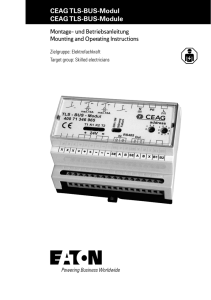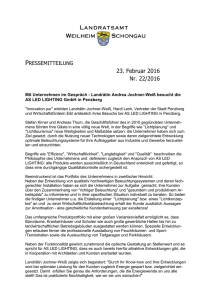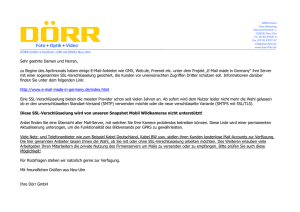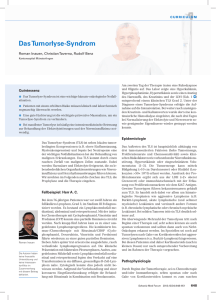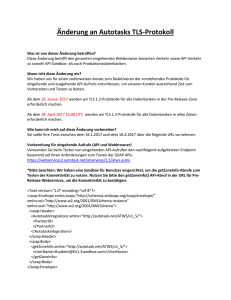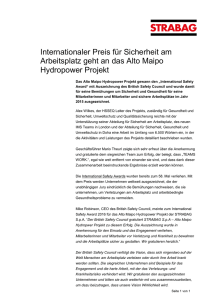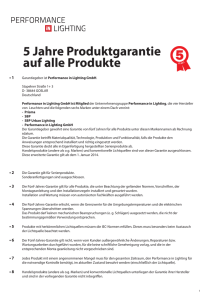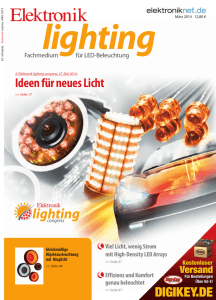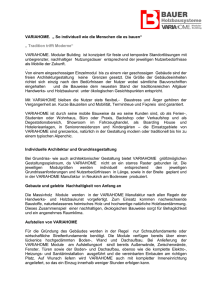Montage- und Betriebsanleitung Mounting and Operating
Werbung
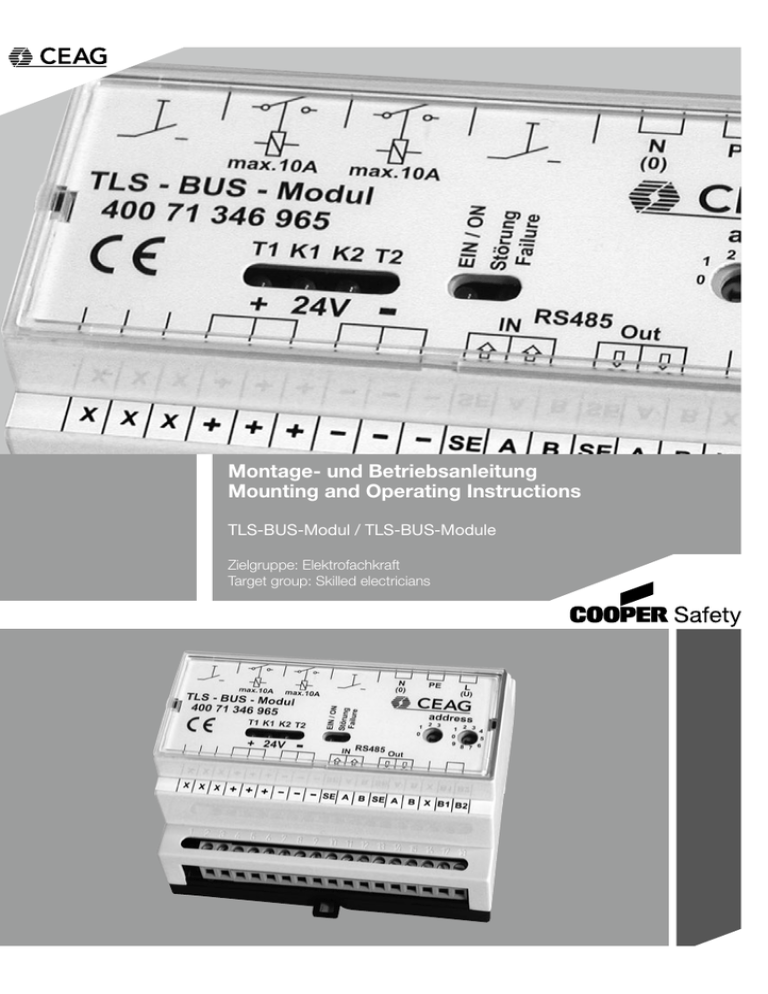
Montage- und Betriebsanleitung Mounting and Operating Instructions TLS-BUS-Modul / TLS-BUS-Module Zielgruppe: Elektrofachkraft Target group: Skilled electricians Montage und Betriebsanleitung TLS/3PH-BUS-Modul Sicherheitshinweise Anschluss T1/T2: max. je 50 mA z.B. 50 Taster mit Glimm lampe 1 mA Anschluss K1/K2:10 A /250 V AC Einschaltstrom max.120 A/ms Datenbus: RS 485 Adressbereich: 1 - 25 Gewicht: 0,2 kg Abmessungen L x B x H/mm: 105 x 85 x 60 Montage:DIN-Schiene Anschlussklemmen: 2,5 mm² starr und flexibel Funktionsweise Das TLS-Bus-Modul dient dem Betrieb und der Abfrage wachungsgerät TLS-BUSvon beleuchteten Tastern (mit Modul ist bestim­mungs­­­ Glimmlampe 230V) wie z.B. in gemäß in unbeschädigtem Treppenhäusern eingesetzt werund einwandfreiem Zustand den. Die Taster werden von einer zu betreiben! CEAG Notlichtanlage mit einer gesicherten Spannung versorgt. Bei Durchführung von ArDas Modul hat 2 Tasterstränge beiten am Gerät ist sichermit je einem zugehörigem pozustellen, dass das Gerät tentialfreien Relaiskontakt zum span­nungs­frei geschaltet Schalten der Allgemeinbeleuchist! Beachten Sie dabei tung. Die Anzeige von Taster die unter­schiedlichen Ver­ und Relaisfunktion erfolgt mitsorgungen des Geräts bei tels gelber LED. Das Modul ist Normal- und Notbetrieb. über eine RS 485 Schnittstelle, Beachten Sie bei allen Ar­­­­­­­­­­­­­­ der 24 V DC-Versorgung sowie beiten an dem Gerät die na- Beschreibung/ einer gesicherten Spannung tionalen Sicherheits- und Verwendungsbereich (zur Erzeugung der Glimm­ UnfallverhütungsvorschrifDas elektronische Schaltgerät lampenspannung) mit der CEAG ten und die nachfolgenden dient in Verbindung mit CEAG Notlichtanlage verbunden. Sicherheitshinweise in der Sicherheitsbeleuchtungs­ Die Tastfunktion wird an die Betriebsanleitung, die mit anlagen Typ ZB-S und CEAG Notlichtanlage über den einem versehen sind! CG 2000 zur LichttasterabfraBUS weitergeleitet. Die an der ge, wodurch Leuchten der AllNotlichtanlage angeschlosNormenkonformität gemeinbeleuchtung und Leuch- senen Sicherheitsleuchten Konform mit: ten der Sicherheitsbeleuchtung eines Kreises werden von der EMV-Richtlinie 89/336/EWG, im Netzbetrieb innerhalb eines Anlage für die programmierte Niederspannungsrichtlinie Treppenhauses gemeinsam ge- Treppen­hauslichtzeit (1 - 15 73/236/EWG, EN 50081-1, schaltet werden können. min) eingeschaltet. Gleichzeitig EN 61000-6-2, EN 50178, schließt der dem Strang zugeSchaltschwellen gem. Installation hörige Relaiskontakt K1/K2 für EN 60598-2-22, EN 50171 und Halten Sie die für das die programmierte Zeitdauer, VDE 0108. Errichten und Betreiben um ggf. zusätzliche Leuchten Gemäß DIN EN ISO 9001 entvon elektrischen Be­triebs­­­mitteln der Allgemeinbeleuchtung zu wickelt, gefertigt und geprüft. geltenden Sicher­heits­vorschriften, schalten. Damit kann der sonst das Geräte­­sicherheitsgesetz so- übliche Treppenhausautomat wie die allgemein anerkannten Technische Daten entfallen. Regeln der Technik ein! Versorgungsspannung 30 Sek. vor Ablauf der eingeGerät: 24 V DC stellten Einschaltzeit beginnen Montage (min. 19 V, die angeschlossenen GlimmDer Einbauort ist gemäß der ein max. 30 V) lampen der Taster zu blinken. schlägigen Errichtungsnormen zu Stromaufnahme bei 24 V Die grüne LED in der Frontplatwählen (z.B. Unterverteilungen). Standby: 10 mA ± 3 mA te signalisiert störungsfreien Hierbei ist auf unzulässige Tem1 gedr. Taster: 35 mA ± 5 mA peraturen am Einbauort während Betrieb, die rote LED zeigt eine 2 gedr. Taster: 60 mA ± 6 mA Störung an. Werden mehrere des Betriebs zu achten. Schutzart: IP 20 Module (max. 25) an einer Schutzklasse:I Anlage betrieben, so ist der UmgebungsRS 485 Bus wie auch die 24 V temperatur: -10 °C .. +40 °C Versorgung hintereinander zu schalten. Der Schirm der BUSDas elektronische Über­ 2 Montage und Betriebsanleitung TLS/3PH-BUS-Modul T1 T1 X K1 K1 X K2 K2 X T2 T2 X N N PE PE L N PE (0) L (U) max.10A 400 71 346 965 T1 K1 K2 T2 address Failure EIN / ON TLS - BUS - Modul St”rung max.10A 1 0 2 3 1 + 24V X X X + + + - - IN - SE A RS485 2 3 8 7 Out B SE A B X B1 B2 PE PE Servicetaster zur Überprüfung der Kommunikation Modul Sicherheitsbeleuchtungsanlage über den RS 485-BUS L N PE 7 Bild 18 TLS Modul L2 Anschlussbild L3 * = 3PH * address DLS 1 0 3 PH 2 3 1 2 3 9 8 7 Vor Betrieb an einer CEAGSicherheitsbeleuchtungsanlage muss die Moduladressierung vorgenommen werden. Hierzu ist mit einem geeigneten Schraubendreher die gewünschte Adresse (1 - 25) an den zwei Codierschaltern in der Frontplatte des Moduls einzustellen (Pfeil auf Zahl, Bild 2). 6 5 Out E A B 6 Am Anfang und am Ende der BUS-Leitung ist jeweils ein Abschlusswiderstand (120 Ω) zu installieren. Hierfür sind im jeweils letzten Modul die Klemmen B1/B2 mit einer Brücke zu versehen, die den eingebauten Abschlusswiderstand aktiviert. Ist die Sicherheitsanlage Anfang der Busleitung, so ist an den hierfür vorgesehenen Klemmen der entsprechende Abschlusswiderstand zu installieren. Die Versorgung der Tasterglimmlampen mit einer gesicherten Netzspannung muss über eine separate Stromkreisumschaltung (SKU) von der Notlichtanlage erfolgen (gesichertes Netz). Adressierung 4 5 0 4 5 0 9 N Leitung ist mit einer geeigneten Klemmvorrichtung an den Klemmen SE anzuschließen. L X B1 B2 Bild 2 Adress-Adressschalter 1 schalter 2 Adressschalter 1 Adressschalter 2 0 0 01 02 ...... 10 11 ...... ...... 25 2 6 ...... 3 9 Moduladresse nicht zulässig 1 2 ... 10 11 ... ... 25 nicht zulässig ... nicht zulässig 3 Montage und Betriebsanleitung TLS/3PH-BUS-Modul K1 Reilais K1 AC/DC schließt Kontakt K1 bei Spannungsausfall Kontakt schließt bei Spannungsaufsfall, Allgemeinbeleuchtung bleibt in Dauerlicht Soll bei getrennter Batterieleitung die Allgemeinbeleuchtung eingeschaltet bleiben, muss das Relais k1 zusätzlich – wie im Installationsbeispiel gezeigt – installiert werden. K1 Bild 3: Schaltung eines TLS- BUS-Moduls DLS TLS RS485-BUS TLS Abschlusswiderstand* 120 Ω ZB-S max. 1200 m bei J-Y(ST)Y 4 x 2 x 0,8 mm DLS *Abschlusswiderstand 120 Ω Bild 4. Busstruktur RS485-BUS Double Terminated Bus Topologie/Linienstruktur max. 25 Module (DLS/TLS) Querschnitt für 24 V-Versorgung ist gemäß Anzahl der MOdule sowie Leitungslänge zu berechnen. Umin für Modul = 19 V Empfolene Leitung: JY(ST)Y 4 x 2 x 0,8 mm, Twisted Pair (verdrillte Zweidraht-Leitung), geschirmt Keine Stichleitungen zulässig! 4 *Im TLS-Bus-Modul ist der 120 Ohm-Abschlußwiderstand integriert und kann durch eine Brücke an den Klemmen B1/B2 aktiviert werden. Bitte lesen Sie dazu auch Seite 3. Mounting and Operating Instructions TLS/3PH-BUS-Module Safety Instructions The electronic monitoring module shall only be used for its intended purpose and in undamaged and perfect condition! When working on the electronic device make sure that it is disconnected from the voltage! Pay attention to the different power supplies in mains or battery operation. Connection to T1/T2: max. each 50 mA e.g. 50 push- buttons with glow lamp 1 mA Connection to K1/K2: 10 A /250 V AC Inrush current max.120 A/ms Data bus: RS 485 Address range: 1 - 25 Weight: 0.2 kg Dimensions L x W x H/mm: 105 x 85 x 60 Assembly:DIN-Rail Terminals: 2.5 mm² rigid and flexible Assembly The installation location is to be chosen in accordance with the applicable construction standards (e.g. subdistribution boards). During this process attention is to be paid to temperatures outside the permitted range at the installation location during operation. Principle of operation The TLS bus module is used for operating and monitoring light switches (with glow lamp 230V), e.g., as are used in staircases. The switches are supplied from Observe the national safety a CEAG emergency lighting sysrules and regulations for tem with a protected supply. The prevention of accidents as Description/Scope of module has 2 switch phases each well as the safety instrucwith a related potential-free relay tions included in these application operating instruction marked The electronic switchgear is used contact for switching the general lighting. The switch and relay with in combination with CEAG safety functions are displayed using a lighting systems of type ZB-S and yellow LED. The module is conCG 2000 for light switch moniConformity with nected to the CEAG emergency toring. In this way luminaires for lighting system via an RS 485 instandards general lighting and luminaires for terface, and to the 24 V DC supply Conforming to: EMC-directive safety lighting within a staircase as well as a protected supply (for 89/336/EWG, Low Voltage Direccan be switched together during the generation of the glow lamp tive 73/236/EWG, mains operation. supply). EN 50081-1, EN 61000-6-2, The monitoring function is forEN 50178, Switching point accd. Installation warded to the CEAG emergency EN 60598-2-22, For the mounting and lighting system over the BUS. The EN 50171 and VDE 0108. operation of electrical safety luminaires on a circuit conDeveloped, manufactured and apparatus, the respective national nected to the emergency lighttested acc. to ISO 9001. safety regulations as well as the ing system are switched on by general rules of engineering will Voltage supply the system for the programmed have to be observed. module: 24 V DC staircase lighting time (1 - 15 min). (min. 19 V, At the same time, the relay conMounting max. 30 V) tact K1/K2 related to the phase Observe the safety regulations current consumption at 24 V closes for the programmed time applicable for setting up and Standby: 10 mA ± 3 mA to switch on additional luminaires operating electrical equipment, 1 pushed key: 35 mA ± 5 mA for the general lighting if necesthe Geraetesicherheitsgesetz 2 pushed keys: 60 mA ± 6 mA sary. In this way the staircase (German law on equipment safety) timer otherwise used is no longer Degree of as well as generally recognised protection: IP 20 required. 30 sec. prior to the end engineering principles! Insulation class: I of the switch on time set, the glow Perm. ambient lamps for the switches connected temperature: -10 °C .. +40 °C start to flash. The green LED on the front panel indicates malfunction-free operation; the red LED indi5 N Mounting and Operating Instructions TLS/3PH-BUS-Module T1 T1 X K1 K1 X K2 K2 X T2 T2 X N N PE PE L N (0) max.10A PE L L (U) T1 K1 K2 T2 address Failure EIN / ON 400 71 346 965 St”rung max.10A TLS - BUS - Modul 1 0 2 3 1 9 + 24V L L N 7 * L2 X X N X PE PE + + + - - IN - SE A RS485 2 3 4 5 0 8 7 6 Out B SE A B X B1 B2 Service key for testing of the communication between module safety lighting via RS 485-BUS PE 8 L3 fig. 1 Connections TLS module * = 3PH * address DLS 1 0 3 PH 2 3 1 2 3 9 4 5 0 8 7 6 S485 Out B SE A A terminating resistor (120 W) must be fitted at the start and end of the BUS cable. For this purpose, a jumper is to be fitted to terminals B1/B2 on the last module; this activates the builtin terminating resistor. If the safety system is at the start of the bus cable, then the appropriate terminating resistor is to be fitted to terminals provided for this purpose. The supply for the switch glow lamps with a protected mains supply must be provided from the emergency lighting system using a separate changeover circuit (protected mains). Addressing B Prior to operation in a CEAG safety lighting system, the module address must be set. For this purpose the required address (1 - 25) is to be set on the code switches on the module front panel using a suitable screwdriver (arrow to number, Figure 2). X B1 B2 fig. 2 Address-Addressswitch 1 switch 2 Address swtch 1 Address switch 2 0 0 01 02 ...... 10 11 ...... ...... 25 2 6 ...... 3 9 6 cates a malfunction. If several modules (max. 25) are operated in a system, then the RS 485 bus and the 24 V supply are to be connected in series. The screen on the BUS cable is to be connected to the SE terminals using a suitable clamping arrangement. Module addresse not permissible 1 2 ... 10 11 ... ... 25 not permissible ... not permissible Mounting and Operating Instructions TLS/3PH-BUS-Module To remain on the general lighting while the battery line is separated, the relay k1 has to be installed as shown in the installation example. fig. 3: Wiring of the TLS- BUS-Moduls DLS TLS RS485-BUS TLS Terminating* resistor 120 Ω ZB-S max. 1200 m with J-Y(ST)Y 4 x 2 x 0.8 mm DLS *Terminating resistor 120 Ω fig.4 Bus structure RS485-BUS Double terminated bus topology/Line structure max. 25 modules (DLS/TLS) Cross section for 24 V supply must be calculated according the number of modules as well as line length. Umin for module = 19 V recommend cable: JY(ST)Y 4 x 2 x 0.8 mm, twisted pair, shielded No dead-end lines allowed. * In TLS-Bus-modul the 120 ohms terminating resistor is integrated and can be activate through a wire fitted to terminals B1/B2. Please read back page 6. 7 CEAG Notlichtsysteme GmbH Senator-Schwartz-Ring 26 59494 Soest Germany Tel: Fax: Web: Email: +49 (0) 2921/69-870 +49 (0) 2921/69-617 www.ceag.de [email protected] 300 80 001 643_C/XXX/09.14/XX Cooper Safety Jephson Court Tancred Close Royal Leamington Spa Warwickshire CV31 3RZ United Kingdom Tel: Fax: Web: Email: +44 (0) 1926 439200 +44 (0) 1926 439240 www.cooper-safety.com [email protected]
